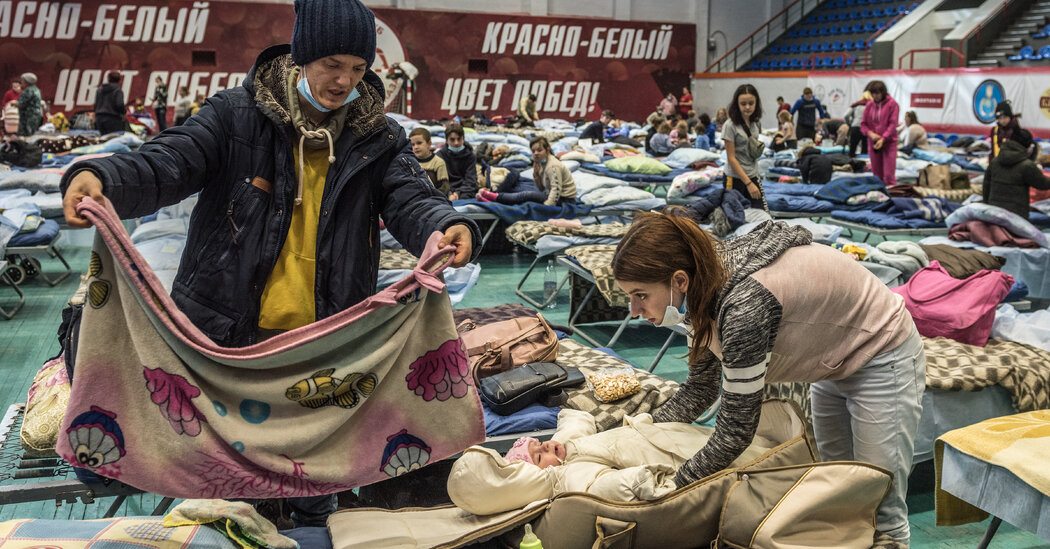
KYIV, Ukraine — Russian military exercises on Ukraine’s border were extended indefinitely on Sunday, leaving an unrelenting threat hanging over a vastly outgunned Ukrainian military and jittery population after a weekend of shelling and evacuations that American and Ukrainian officials warned was an effort by Moscow to create a pretext for an invasion.
The defense minister of Belarus said the war games in the country, which borders Ukraine and where some 30,000 Russian forces were taking part in the drills, would continue because of heightened tensions in eastern Ukraine. Russian-backed separatists in the region have evacuated thousands of civilians ahead of what they said was an impending assault by Ukrainian forces.
With an estimated 190,000 Russian forces now massed on their nation’s borders and in breakaway areas, Ukrainian officials dismissed any intention of mounting an attack in the eastern Donbas region, where Ukrainian forces and Russian-backed separatists have been locked in a military standoff.
After a weekend of scattered but intensifying artillery shelling, the bombardment of the Ukrainian Army in Donbas was at perhaps its highest peak in seven years, stretching along the entire front. American and Ukrainian officials warned that pro-Moscow separatist leaders have been reporting false events or staging incidents intended to provide Russia with an excuse to push deeper into Ukraine.
On Sunday evening, the Ukrainian military issued a statement saying the Russian-backed separatists in the Luhansk region had opened fire with heavy artillery on their own capital city “with the goal of blaming the Ukrainian military.” “In the absence of any aggressive action from the Ukrainian defenders, the occupiers themselves are blowing up infrastructure in the occupied territories and firing chaotically on towns,” the statement said. Russian news agencies reported artillery strikes in the area. There were no immediate reports of casualties.
On Saturday, separatist leaders released a video of a man they said was a Ukrainian spy involved in a plot masterminded by Kyiv to retake territory from the breakaway, self-proclaimed Donetsk People’s Republic.
Russia’s state-owned Channel One on Saturday broadcast an interview with a man who said he had been tasked with blowing up the car of Donetsk’s security chief, as part of a five-day plan to violently reclaim the city and its environs. He said he had smuggled weapons and explosives into the city. The explosion was among the events that precipitated mass evacuations of people living in the separatist republics that began shortly thereafter.
Kyiv has repeatedly denied the allegations.
“This morning, regular portions of lies and new videos about fictional events were flung at us,” Ukrainian Defense Minister Oleksii Reznikov said Saturday in Munich, during a trip accompanying President Volodymyr Zelensky. “The accumulation of this nonsense only convinces everyone that Ukraine is defending itself from a vicious aggressor who is willing to sacrifice women and children to destroy peace.’’
He called the ongoing information war between Ukraine and the West on one side and Russia on the other a “clash of civilizations.”
Russian propaganda and disinformation, American and Ukrainian officials say, is being used to sow confusion and concoct a false narrative about who is actually threatening whom. The exercises in Belarus, the Biden administration says, are part of a Russian buildup of troops that could be used as a force to invade Ukraine — a step the administration believes President Vladimir V. Putin of Russia has decided to take.
U.S. officials said on Sunday that American intelligence agencies learned last week that the Kremlin had given the order for Russian military units to proceed with an invasion. Officials declined to describe the intelligence in any detail. But the information prompted President Biden to announce that Mr. Putin had made a decision to attack, they said.
Nevertheless on Sunday, Secretary of State Antony J. Blinken, said that President Biden was still willing to pursue diplomacy “until the tanks are actually rolling, and the planes are flying.”
The United States government has sent a letter to the United Nations office in Geneva saying it has “credible information” that Russian forces have compiled a list of specific Ukrainian citizens to be killed or sent to detention camps in the aftermath of a Russian invasion and takeover of Ukraine, according to a copy of the letter obtained Sunday by The New York Times. The letter also said Russian forces plan to torture and kidnap people who would be opposed to Russian actions. The Washington Post first reported on the letter on Sunday, and other news organizations reported on a Russian “kill list” last week.
The extension of the military exercises on Ukraine’s border came despite repeated assurances from Russia and Belarus that the drills would end this weekend, and it was cited by Moscow’s critics as further evidence that Mr. Putin is committed to using his foothold in eastern Ukraine to take over the entire country.
“Russian troops stay on in Belarus violating all guarantees to withdraw,” Lithuania’s foreign minister, Gabrielius Landsbergis, said in a Twitter post. “It’s a clear preparation to attack Ukraine towards Kyiv & creeping annexation of Belarus,” which has grown closer to Moscow since its strongman leader violently suppressed pro-democracy protests in 2020.
The growing sense of menace took on added resonance Sunday, eight years to the day when dozens of pro-democracy protesters in Kyiv’s central Maidan square were gunned down and killed by forces loyal to a Ukrainian government allied with Moscow.
The massacre helped set in motion a chain of events that led to the ouster of Ukraine’s president at the time — and eventually the Russian annexation of Crimea and the eruption of a war led by Russia-backed separatists.
Every year Iryna Horbachova goes to Maidan square on Feb. 20 to commemorate the pro-democracy protesters who were killed in 2014, a fight that feels all the more urgent with the threat of Russian invasion today.
The Maidan was part of an ongoing Ukrainian struggle, said Ms. Horbachova, 36, for “our right to live in the kind of Ukraine we want — not the kind Putin and Russia wants to drive us into.”
If eight years ago Ukrainians could not believe that their own police would shoot civilians in the heart of the capital, today they struggle to believe that a full-scale Russian invasion could be possible. The atmosphere in the country is infused with a mix of determination and trepidation, if not panic.
The Ukrainian military has tried to build itself up in recent years, especially since Russia’s annexation of Crimea in 2014. The United States alone has provided $2.5 billion in military assistance that has included high-tech surveillance, communications equipment and drones. In November, the United States delivered about 88 tons of ammunition, part of a $60 million military aid package pledged by the Biden administration.
But Ukraine remains vastly outmatched by the Kremlin’s forces, and members of Mr. Zelensky’s governing party, Servant of the People, have sought to tamp down fears of a new Russian invasion.
Even if the announcement of the continuing exercises in Belarus was not a prelude to invasion, having the troops so close to Ukraine, has kept the country on edge and inflicted increasing damage to its economy.
For their part, the separatist leaders in the breakaway Donbas region took steps over the weekend to create a kind of carnival-mirror reflection of what was going on elsewhere in Ukraine.
They warned of an imminent threat, called for men of military age to stay and take up arms against a possible attack by Ukraine, and suspended a range of public activities including “leisure, entertainment, entertainment, cultural, exhibition, educational, public and other similar events,” according to a statement posted on their Telegram channel.
The government in Kyiv has repeatedly denied any plans to attack the region, and the rebel leaders produced no evidence to support their claim.
Of the thousands of civilians the separatists evacuated so far, some went to stay with relatives in Russia, while others were temporarily put up in tents by the authorities before being relocated to towns and cities in Russia.
While Moscow has tried to portray the flow of refugees as proof of Ukraine’s menacing posture, the evacuees who passed through the train station in Taganrog, a Russian city perched on the Azov Sea near the border with Ukraine, appeared to be helpless, frightened by the rebel leaders’ warnings but uncertain about what lay ahead.
The Russian authorities “lied to us,” fumed Lyudmila V. Ladnik, 62, who had left her home in Debaltsevo, which is part of the Donetsk People’s Republic.
She said that she had been told that residents of the separatist areas would stay temporarily in Rostov, but on Sunday she learned they would be moved farther inside Russia, to a town such as Kursk. With dismay, she wondered whether her evacuation to Russia would be longer than she had expected.
“We are now calling everyone back home, telling them to stay,” she said.
The commander of Ukraine’s Armed Forces said in a statement that refugees are being “used to escalate the situation in order to provoke another round of bloodshed.”
Ms. Horbachova, on Maidan square, said the last thing she wanted to see in Ukraine was more blood spilled.
“For eight years, we have war; for eight years our people have been dying for our identity and for our freedom,” she said tearfully. “Of course there is a feeling of anxiety” as the tension escalates day by day. “But this is not a feeling that is forcing you to pack your bags, it is forcing you to be strong and protect your country.”
Reporting was contributed by Ivan Nechepurenko from Taganrog, Russia; Michael Schwirtz from Odessa, Ukraine; Maria Varenikova and Marc Santora from Kyiv; and Julian E. Barnes, Eric Schmitt and Edward Wong from Washington.







